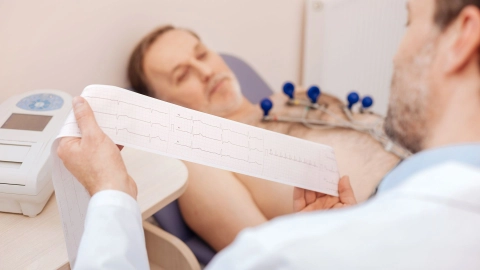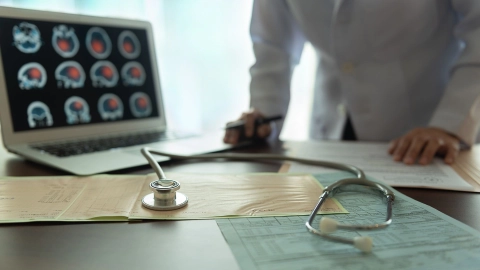Conditions Atrial fibrillation
ICD codes: I48 What are ICD codes?
The most common indications of atrial fibrillation are palpitations and a pounding heartbeat that is often too fast. The condition is not immediately life-threatening but does increase the risk of stroke and can permanently weaken the heart. Atrial fibrillation can be treated in various ways.
At a glance
- Atrial fibrillation is a type of cardiac arrhythmia, i.e., an abnormal heart rhythm.
- It causes an irregular heartbeat, which is often too fast.
- When this happens, the heart can no longer pump as much blood around the body.
- Atrial fibrillation is generally the result of another chronic condition, such as high blood pressure or coronary heart disease.
- Atrial fibrillation increases the risk of having a stroke.
- There are a number of ways to relieve the symptoms and reduce the risk of stroke.
Note: The information in this article cannot and should not replace a medical consultation and must not be used for self-diagnosis or treatment.

What is atrial fibrillation?
With atrial fibrillation, the signals that regulate the heartbeat are disrupted. As a result, the heart frequently beats too quickly and inconsistently. This means that it is no longer able to pump as much blood around the body. People with atrial fibrillation may feel faint or have symptoms such as clearly noticeable palpitations.
Atrial fibrillation is generally the result of another chronic condition, such as high blood pressure or coronary heart disease. It is sometimes impossible to clearly identify the cause.
Atrial fibrillation is the most common form of cardiac arrhythmia. It is not immediately life-threatening. In the long term, however, atrial fibrillation increases the risk of a stroke and can also weaken the heart.
Video How does the heart function?
This video provides more information about the function and role of the heart.
This and other videos can also be found on YouTube
Watch nowThe privacy policy indicated there applies.
What are the symptoms of atrial fibrillation?
The most common indication of atrial fibrillation is a clearly noticeable pounding heart (“palpitations” to use the medical term). This usually means that the heart is beating faster and less regularly than normal. The heart rate with atrial fibrillation can be far higher than the healthy resting rate of between about 60 and 90 beats per minute.
People with atrial fibrillation may also feel weak and faint. Dizziness and chest tightness are other possible symptoms. However, over half of all people with atrial fibrillation have either no symptoms or only inconclusive symptoms – at least at first.
People who have additional heart problems alongside atrial fibrillation may have more symptoms. In the case of heart failure, for example, atrial fibrillation may noticeably reduce the heart’s performance. This can result in symptoms such as a shortness of breath and exhaustion, especially during physical exertion.
What are the causes of atrial fibrillation?
When the heart beats, the heart muscles rhythmically contract and pump blood into the circulatory system. The heartbeat is regulated by an electrical conduction system. The sinus node generates the signal for a new heartbeat. This is sometimes also referred to as the heart’s “natural pacemaker”.
The sinus node is a cluster of special cells in the wall of the right atrium. The electrical signals from the sinus node are transmitted along the conduction pathways to the atrioventricular node (AV node) and then on to the heart’s chambers. A normal heartbeat is also known as the sinus rhythm.
In people with atrial fibrillation, irregular electrical signals quickly spread through the upper chambers (atria). The sinus node is inactive during atrial fibrillation. As a result, the atria no longer contract and relax in a steady rhythm. Instead, they quiver rapidly and uncontrollably: they “fibrillate”.
The upper chambers of the heart normally help the lower chambers (ventricles) to quickly fill up with blood. Atrial fibrillation reduces the heart’s performance. The lower chambers still pump blood through the body, but they pump less blood less regularly than before.
Atrial fibrillation can have several causes. The most common of these include:
- high blood pressure (hypertension)
- coronary heart disease
- heart attack
- heart failure (although this can also be the result of atrial fibrillation)
A heart valve defect or an overactive thyroid gland and certain medication can also cause atrial fibrillation. In some cases, the cause cannot be clearly identified.
What are the risk factors for atrial fibrillation?
The likelihood of atrial fibrillation increases with age. According to estimates, about 2 percent of the total population and about 8 percent of over-65-year-olds are affected.
The risk of atrial fibrillation is higher for people whose close relatives (parents or siblings) have the same condition. The risk is higher for men than for women. People with fair skin are also more likely to have atrial fibrillation than those with other skin tones.
The risk factors for atrial fibrillation include high or frequent alcohol consumption, smoking, diabetes mellitus, high blood pressure, being significantly overweight and sleep apnea. Some of these risk factors are things that people can influence themselves.
How does atrial fibrillation progress?
Atrial fibrillation usually starts with rare, short episodes. Over time, longer episodes may occur or the fibrillation may persist permanently. There are four different types, depending on the length of the episodes:
- With “intermittent” (paroxysmal) atrial fibrillation, the heart rhythm usually returns to normal of its own accord and without treatment within about 48 hours. However, this can also last for up to 7 days. Intermittent atrial fibrillation can occur as a one-off or repeatedly.
- Persistent atrial fibrillation lasts more than seven days.
- Long-standing persistent atrial fibrillation lasts for over a year.
- Permanent atrial fibrillation does not usually go away again.
However, classification into these four types is of limited value. This is because it is often unclear whether a person has experienced atrial fibrillation in the past or how long the condition has been present.
What are the long-term effects of atrial fibrillation?
In the long term, atrial fibrillation can cause various secondary diseases, in particular:
- Heart failure: If the atria are no longer pumping correctly, the rest of the heart has to work harder to supply the body with blood. Over time, this can place excessive strain on the heart and cause it to weaken. Pre-existing heart failure may worsen as a result.
- Stroke: In people with atrial fibrillation, the upper chambers of the heart are no longer able to pump a sufficient amount of blood. As a result, the blood takes longer to flow into the ventricles, it gets clogged there as a result and is more likely to form clots. If a blood clot travels through the bloodstream and reaches the brain, it can block a blood vessel there and cause a stroke.
How is atrial fibrillation diagnosed?
As atrial fibrillation does not always have symptoms, it can sometimes be detected by chance. For example, if the electrical signals to the heart are investigated due to another condition.
Several investigative methods can be used to obtain a precise diagnosis, determine the causes and plan the treatment:
- Recording the medical history (anamnesis): the doctor asks about symptoms, pre-existing medical conditions, age and family history, as well as risk factors for heart conditions.
- Physical examination: for example, heart rate and blood pressure measurements.
- Electrocardiogram (ECG): an ECG can diagnose atrial fibrillation with a high degree of certainty. During this process, several electrodes are attached to the body to measure the electrical signals to the heart.
- Blood test: a blood test can be used to assess thyroid function among other things. An overactive thyroid gland or an overdose of thyroid medication can cause atrial fibrillation.
- Echocardiogram: this ultrasound scan of the heart makes it possible to check its pumping power, for example. However, echocardiography can also be used to detect rarer causes of atrial fibrillation, such as certain heart valve problems.
Other tests are mainly used to help plan treatment. For example, kidney and liver function can be determined because some medication is not suitable for people with kidney or liver weaknesses.
How is atrial fibrillation treated?
Treatment of atrial fibrillation has two goals. Firstly, it seeks to eliminate or at least relieve the symptoms caused by the person’s disrupted heart rhythm. Secondly, it aims to prevent the person from having a stroke. There are various ways to achieve these goals.
Treating symptoms
- Heart rate control: the excessively high heart rate is permanently reduced with medication, usually a beta blocker. This reduces strain on the heart and helps relieve symptoms. With heart rate control, there is no attempt to eliminate the atrial fibrillation itself.
- Heart rhythm stabilization: this strategy attempts to restore and stabilize the heart’s normal rhythm. This is usually done in a hospital by delivering controlled electric shocks. Treatment with medication or catheter ablation normally follows to prevent relapse. Catheter ablation involves using a heart catheter to deliberately destroy specific parts of the heat tissue – using either energy or freezing.
Both approaches serve to improve symptoms such as palpitations, dizziness and feeling faint and thus also improve quality of life. Rhythm stabilization is particularly beneficial if heart rate control fails to relieve symptoms to a sufficient degree.
Preventing stroke
People with atrial fibrillation also have to decide, in consultation with their doctor, whether they need to take medication to reduce the risk of stroke and, if so, which. Oral anticoagulants inhibit blood clotting and can reduce the risk of stroke very effectively.
It makes sense to carefully weigh up the benefits (stroke prevention) and drawbacks (risk of bleeding). A special risk calculator can help people to determine their own risk of stroke and bleeding.
For more detailed information about preventing a stroke as well as a decision aid to help choose a treatment, see gesundheitsinformation.de.
As well as treating symptoms and preventing a stroke, it is also important to treat any accompanying conditions, such as high blood pressure or coronary heart disease.
What other useful information is there about atrial fibrillation?
If the heart beats normally, you do not generally notice it. With atrial fibrillation, in contrast, patients may feel that their heart is no longer beating normally. This is often so concerning that they consult their doctor.
If atrial fibrillation is detected, many people are initially very worried. However, this condition and its symptoms can usually be treated easily. Training courses can also be helpful for people with atrial fibrillation – they explain how to deal with the condition on a daily basis and how to take medication correctly.
However, many people with atrial fibrillation still have concerns. Some wonder if they need to be more cautious now or can still lead as active a life as usual, for example by playing sports. There is no reason not to do so from a medical point of view and studies indicate that moderate physical activity does not cause harm in people with atrial fibrillation but can improve their physical fitness.
- Agasthi P, Lee JZ, Amin M et al. Catheter ablation for treatment of atrial fibrillation in patients with heart failure with reduced ejection fraction: A systematic review and meta-analysis. J Arrhythm 2019. 35(2): 171-181. doi: 10.1002/joa3.12146.
- Arzneimittelkommission der deutschen Ärzteschaft (AkdÄ). Leitfaden: Orale Antikoagulation bei nicht valvulärem Vorhofflimmern. Empfehlungen zum Einsatz der direkten oralen Antikoagulanzien Dabigatran (Pradaxa®), Apixaban (Eliquis®), Edoxaban (Lixiana®) und Rivaroxaban (Xarelto®). 2019.
- Asad ZU, Yousif A, Khan MS et al. Catheter Ablation Versus Medical Therapy for Atrial Fibrillation: A Systematic Review and Meta-Analysis of Randomized Controlled Trials. Circ Arrhythm Electrophysiol 2019. 12(9): e007414. doi: 10.1161/CIRCEP.119.007414.
- Briceño DF, Markman TM, Lupercio F et al. Catheter ablation versus conventional treatment of atrial fibrillation in patients with heart failure with reduced ejection fraction: a systematic review and meta-analysis of randomized controlled trials. J Interv Card Electrophysiol 2018. 53(1): 19-29. doi: 10.1007/s10840-018-0425-0.
- Clarkesmith DE, Lip GY, Lane DA. Patients’ experiences of atrial fibrillation and non-vitamin K antagonist oral anticoagulants (NOACs), and their educational needs: A qualitative study. Thromb Res 2017. 153: 19-27. doi: 10.1016/j.thromres.2017.03.002.
- Hindricks G, Potpara T, Dagres N et al. 2020 ESC Guidelines for the diagnosis and management of atrial fibrillation developed in collaboration with the European Association for Cardio-Thoracic Surgery (EACTS): The Task Force for the diagnosis and management of atrial fibrillation of the European Society of Cardiology (ESC) Developed with the special contribution of the European Heart Rhythm Association (EHRA) of the ESC. Eur Heart J 2021. 42(5): 373-498. doi: 10.1093/eurheartj/ehaa612.
- Kasper DL, Fauci AS, Hauser SL et al. Harrison’s Principles of Internal Medicine. McGraw-Hill: New York 2015.
- Khan SU, Rahman H, Talluri S et al. The Clinical Benefits and Mortality Reduction Associated With Catheter Ablation in Subjects With Atrial Fibrillation: A Systematic Review and Meta-Analysis. JACC Clin Electrophysiol 2018. 4(5): 626-635. doi: 10.1016/j.jacep.2018.03.003.
- National Institute for Health and Care Excellence (NICE). Atrial fibrillation: diagnosis and management. NICE Guidelines. No. 196. 2021.
- Risom SS, Zwisler AD, Johansen PP et al. Exercise-based cardiac rehabilitation for adults with atrial fibrillation. Database Syst Rev 2017. 2(2): CD011197. doi: 10.1002/14651858.CD011197.pub2.
- Rush KL, Hatt L, Shay M et al. The Stressors and Coping Strategies of Older Adults With Persistent Atrial Fibrillation Prior to and Following Direct Current Cardioversion. J Appl Gerontol 2017. 36(9): 1145-1165. doi: 10.1177/0733464815608495.
- Salmasi S, Kwan L, MacGillivray J et al. Assessment of atrial fibrillation patients' education needs from patient and clinician perspectives: A qualitative descriptive study. Thromb Res 2019. 173: 109-116. doi: 10.1016/j.thromres.2018.11.015.
- Sethi NJ, Feinberg J, Nielsen EE et al. The effects of rhythm control strategies versus rate control strategies for atrial fibrillation and atrial flutter: A systematic review with meta-analysis and Trial Sequential Analysis. PLoS One 2017. 26; 12(10): e0186856. doi: 10.1371/journal.pone.0186856.
- Turagam MK, Garg J, Whang W et al. Catheter Ablation of Atrial Fibrillation in Patients With Heart Failure: A Meta-analysis of Randomized Controlled Trials. Ann Intern Med 2019. 170(1): 41-50. doi: 10.7326/M18-0992.
- Virk SA, Bennett RG, Chow C et al. Catheter Ablation Versus Medical Therapy for Atrial Fibrillation in Patients With Heart Failure: A Meta-Analysis of Randomised Controlled Trials. Heart Lung Circ 2019. 28(5): 707-718. doi: 10.1016/j.hlc.2018.10.022.
- Voskoboinik A, Kalman JM, De Silva A et al. Alcohol Abstinence in Drinkers with Atrial Fibrillation. N Engl J Med 2020. 382(1): 20-28. doi: 10.1056/NEJMoa1817591.
In cooperation with the Institute for Quality and Efficiency in Health Care (Institut für Qualität und Wirtschaftlichkeit im Gesundheitswesen) (IQWiG).
As at:





